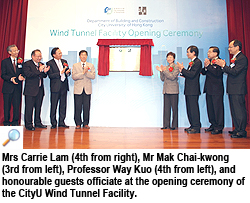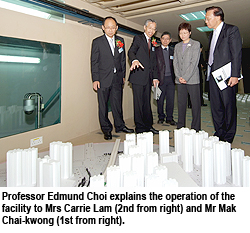CityU wind tunnel promotes sustainable growth in Hong Kong
Guests officiating at the ceremony included Mrs Carrie Lam Cheng Yuet-ngor, Secretary for Development, Mr Mak Chai-kwong, Permanent Secretary for Development (Works), Professor Way Kuo, President of CityU, Professor Richard Ho Yan-ki, the Provost of CityU, Professor Roderick Wong Sue-cheun, Vice-President (Research), CityU, Professor Chan Chi-hou, Dean of the College of Science and Engineering, CityU, Professor Sritawat Kitipornchai, Head of the Department of Building and Construction at CityU, and Professor Edmund Choi Cheong-chuen, staff-in-charge of the Wind Tunnel Facility.
Speaking at the ceremony, Mrs Lam said buildings in Hong Kong had to be made safer and be able to last longer to improve sustainability. “Over the past years, Hong Kong has focused on high density development for economic reasons,” Mrs Lam said. “The time has come for us to strive for a bit of balance between high density and quality environment. I am sure this wind tunnel facility will help us promote a quality urban environment for the benefit of all Hong Kong people.”
Professor Kuo said it is important for a university to adapt its research to the needs of society. “Back in 2005, CityU had foreseen that a wind tunnel would be very useful in studying wind loading and localised ventilation,” Professor Kuo said. “The facility is now operational and will advance the University’s research efforts, complement its undergraduate and postgraduate teaching and serve the community.”
The facility is equipped with automated, state-of-the-art technology that allows it to conduct a range of tests on buildings, bridges, urban ventilation and air pollution. The facility can help test whether a building could withstand extremely strong winds or whether there is adequate ventilation in built-up areas. The tunnel is 20 metres long, with a testing area about 2m high and 2.7m wide. It can generate wind speeds in excess of 20 m/s.
“In Hong Kong, new buildings sprout up every year to sustain the growth of the city. At the same time, there is a growing demand by citizens for better air quality and environmental protection. Wind engineering studies can help strike a balance between the two,” said Professor Kitipornchai. “The facility has strengthened research at CityU.”
The wind tunnel simulates the actual environment on a reduced scale, collecting air flow data in different areas of the tested building. “The CityU Wind Tunnel has features that can more accurately simulate actual environmental conditions,” Professor Choi said. “Aided by accurately-built models, the wind tunnel facility can generate the best results.”



